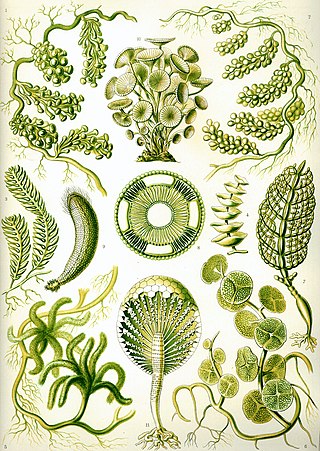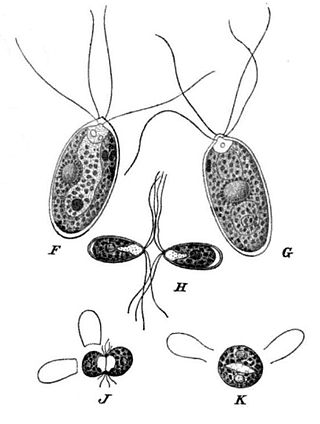
Chlorophyta is a division of green algae informally called chlorophytes.

The water net is a taxon of freshwater green algae in the family Hydrodictyaceae. Hydrodictyon does well in clean, eutrophic water, and has become a nuisance in New Zealand, where it has been recently introduced. The name water net comes from the mesh structure of their colonies, which can extend several decimeters; the scientific name also means "water net" in Greek.

Chlorococcaceae is a family of green algae, in the order Chlamydomonadales. They are mostly soil-dwelling algae. Many members of this group produce lipids and secondary carotenoids.

Asterococcus is a genus of green algae in the order Chlamydomonadales. It is planktonic in freshwater ponds and lakes, or benthic within mires and swamps. It is a common and widespread genus, but is rarely abundant.

Carteria is a genus of green algae in the family Chlamydomonadaceae. Carteria are similar in morphology to the common genus Chlamydomonas and differ by having four, rather than two, flagella at the vegetative stage.

Characium is a genus of green algae in the family Characiaceae. It is very commonly found in freshwater habitats, where it is attached to phytoplankton or zooplankton.

Lobomonas is a genus of green algae in the family Chlamydomonadaceae, found in freshwater habitats. Although it is widely distributed, it is a rare genus.

Neochloris is a genus of green algae in the family Neochloridaceae. It is found in freshwater aquatic and terrestrial soil habitats.

Planktosphaeria is a genus of Chlorophyceae of the green algae. It was first described by the phycologist Gilbert Morgan Smith in 1918, with Planktosphaeria gelatinosa as its type species. Species of Planktosphaeria are commonly found in freshwater plankton around the world.
Pseudoschroederia is a genus of green algae in the family Characiaceae. It is planktonic in freshwater habitats, and probably has a cosmopolitan distribution. The genus Pseudoschroederia was circumscribed by Eberhard Hegewald and Eberhard Schnepf in 1986. The genus was distinguished from the similar Schroederia by being heteropolar and differing cell structure. However, some authors do not consider the genera to be separate.

Schroederia is a genus of green algae in the family Schroederiaceae. Schroederiaceae is a monotypic taxon; Schroederia is its only genus.

Sorastrum is a genus of green algae in the family Hydrodictyaceae. It is a component of the phytoplankton of freshwater ponds, lakes, and ditches. Sorastrum is common in tropical to temperate regions of the world, but due to its small size it is often overlooked.
Vitreochlamys is a genus of green algae in the family Chlamydomonadaceae. It is sometimes known by the name Sphaerellopsis, published by Aleksandr Arkadievich Korshikov. However, that name is an illegitimate later homonym, preceded by SphaerellopsisM.C.Cooke. It is commonly found in freshwater habitats.
Deuterocharacium is a genus of green algae in the family Characiaceae. It is found in freshwater habitats, attached to algae or detritus. It is rare and has only been recorded from Europe.

Chlorotetraedron is a genus of green algae, in the family Neochloridaceae. The name may also be written as Chlorotetraëdon. It is found as freshwater plankton or in soil.

Hydrianum is a genus of green algae, in the order Chlamydomonadales. It is found in freshwater habitats such as marshes and bogs, as an epiphyte on plants or other algae. It is common, but most likely overlooked due to its similarity with similar genera such as Characium.
Korshikoviella is a genus of green algae in the family Characiaceae.
Cecidochloris is a green algae genus in the family Chlorangiellaceae. It occurs in freshwater. However, it has only been reported so far from Europe, with an additional species from India that is incompletely described.

Apiocystis is a genus of algae belonging to the family Tetrasporaceae. It is found attached to freshwater aquatic algae or plants. The species of this genus are found in Europe and Northern America, and are widespread but generally uncommon.

Chlorangiella is a genus of microscopic green algae, the type genus of the family Chlorangiellaceae. The name Chlorangiella was coined by Giovanni Battista de Toni in 1889. It is a nomen novum for Chlorangium F.Stein.















